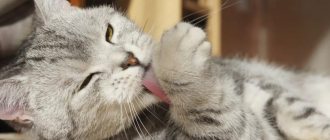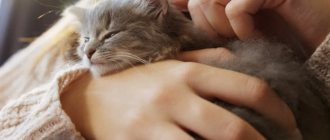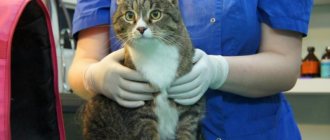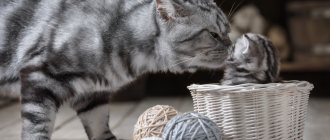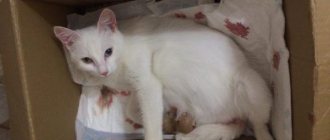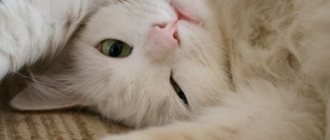Newborns, still blind and deaf, kittens give the impression of completely helpless creatures. They comically spread their paws in all directions and raise their heads with small ears, still pressed to the sides of their heads. They weigh from 70 to 130 g.
The whole meaning of their life is still in their mother, or rather in her warm belly, with such delicious milky nipples. By the way, most kittens do not suck all nipples in a row, but choose one and use it for their pleasure. Having captured it in their mouth, they massage the mammary gland with their front paws, causing it to lactate more abundantly. At the same time, they fiercely defend their right to the nipple, pushing their own brothers and sisters away from it.
The cat usually purrs loudly, and kittens, from approximately the second day of life, quietly “rumble” in response.
While still not seeing or hearing anything, babies have a developed sense of smell and touch - they find their nipples by smell, and adjust their position relative to the cat using, among other things, thermal receptors.
For the first 48 hours, kittens usually sleep with their heads bowed to their chests. In their sleep, they shudder, “kick their legs” and sometimes squeak. This is the so-called active sleep - and this is natural, because this is the only opportunity for the kitten to move a little, which contributes to the development of muscles that he will need later. Disturbed newborn kittens huddle together or crawl towards a source of warmth - their mother, awkwardly rising on their front legs and dragging their bellies with difficulty. A kitten accidentally falling out of the nest makes absolutely desperate sounds. Both the cat and the breeder react to this sound in exactly the same way - rushing to see what happened.
Healthy kittens look round and plump. Their skin is pink and warm to the touch. If you pinch a kitten, the skin immediately returns to its original place. If you pick it up, it stretches out and swings vigorously in your palm.
Unlike healthy ones, a sick baby is a pitiful sight. He can hardly move, he is cold to the touch and hangs like a rag when he is picked up. Taking a nipple into his mouth, he pushes it out and does not want to suck. Such kittens scream plaintively, shrilly and for a long time. Exhausted kittens are hyperactive - they crawl, looking for help, and fall asleep away from the warmth of their mother and littermates. They rest with their limbs spread out and their heads tilted to the side. These kittens are often rejected by their mother, who believes they will not survive. She pushes them out of the litter, saving her strength for healthy kittens. If the kittens are treated and their body temperature returns to normal, the cat will accept them. Healthy kittens rarely squeak. Typically, a kitten squeaks if it is cold, hungry, or in pain.
A good mother instinctively guards the nest and keeps her kittens clean. At first, after giving birth, she generally tries not to leave the house. She feeds, licks the kittens, massages their tummies and the rectal area of each kitten with her tongue so that they can do “their business” and “cleans up” after them. But, already a couple of days after giving birth, she may be overcome by “wanderlust” and will try to drag the kittens to another secluded place. This is the so-called atavism - an instinctive program inherited from wild ancestors who needed to save their children from predators. And since after the birth there could be some traces left that could lure predators to the nest, the cat had to move the kittens to a new place.
The birth is over, and you are lovingly admiring your proud pet and her numerous offspring... Alas, it’s too early to relax. Any experienced breeder knows that only the behavior of a cat after giving birth can promptly indicate any health problems either for the mother herself or her cubs.
How to bathe a cat for the first time?
So, we found out that your cat should first become acquainted with water and shampoo at a young age. It should be remembered that a kitten has a vulnerable child’s psyche. The owner’s task is not to instill in the baby a persistent aversion to water and the entire procedure as a whole. To do this, you must follow some rules. The baby’s attitude towards this procedure in the future depends on the very first bath.
A kitten should be accustomed to water from three months. Usually, before this age, his mother washes him out. However, there are exceptions to every rule. If a kitten is very dirty at the age of one month, then it can and should be bathed. You should not carry out the first procedure in the bathroom. A basin is more suitable for this, as it doesn’t look as intimidating to a baby as a huge white bathtub, and it will also be easier to keep him in the water.
You need to pour a little water so that it just reaches the kitten’s tummy. While bathing, talk to your baby in a quiet voice and call him by name. Do not wet the kitten's head from the shower; clean the fur on it with a sponge. Use shampoo for kittens, choosing it based on your pet's coat type. If you can’t purchase it, use any children’s one.
General recommendations
Caring and competent owners, as a rule, took care of a place for a pet with kittens in advance. If for some reason the nest was not prepared, then the first thing that needs to be done for the lambing cat is to prepare the nest for the mother and offspring.
The best option for these purposes is a box made of thick cardboard. The bottom should be covered with waterproof material, a soft mattress or many rags should be placed on top, and a disposable baby diaper should be covered. This arrangement will help keep the nest warm, dry, and clean.
A window should be cut in the wall of the box at such a height that it is convenient for the cat to leave the house, and the babies cannot crawl out. The size of the nest must be optimal. In a spacious box it will be difficult for the mother to warm the kittens, and in a cramped room there is a high probability of overheating and injury. A good solution to the problem may be to use an exhibition box.
Owners often wonder: after a cat has lambed, what to do with her and her offspring? The box with the newborn babies and mother should be placed in an isolated room, without access to strangers and animals. The room should be dry, draft-free, darkened. The nest should not be placed near radiators or heating devices.
The optimal ambient temperature is not lower than 26 C. If necessary, additional heating should be used for babies. An electric heating pad with an adjustable temperature setting and an infrared light lamp are suitable for these purposes. You should know that in the first 7 days, newborn kittens need a temperature in the range of 29 - 32 C. This is due to the fact that babies do not have mechanisms to regulate the temperature balance of the body, and they can die from low temperature.
After a successful birth, the owner must monitor the pet’s behavior and observe whether all kittens have access to the mother’s nipples. Helping a cat should be unobtrusive. Newborns should only be handled as a last resort. This must be done by first washing and disinfecting your hands, wearing sterile gloves. The immune system of babies is weak, so the risk of developing viral diseases is high.
How to bathe an adult cat?
If you have not taught your pet to bathe from a young age, then this procedure becomes much more complicated. However, do not think that your attempt is doomed to failure. Below we will present you with tips and recommendations from experienced owners and veterinarians who will certainly answer the question of how to bathe a cat without scratching it.
To bathe an adult animal, use dry or liquid shampoos for cats; in rare cases, it is allowed to use shampoo for people, as well as baby soap.
Cleansing with dry shampoo
This is the simplest, most gentle way. What are its advantages over the traditional one? Using dry shampoo will not make your cat nervous, and your hands will remain intact.
You can use this product once every six months. In this case, the procedure will not become more complicated than regular combing. But you should know that if it is carried out on a carpet, then it will be quite difficult to clean it from the powder. After rubbing the shampoo a little into the animal's fur, comb it thoroughly.
Preparing for a swim
First of all, trim the cat's claws, this will protect your hands from deep and rather painful scratches. Brush the fur a little so that it doesn't get too tangled during bathing. This is especially important for long-haired animals. All matted wool is cut off if it cannot be untangled.
If a small amount of water is enough to bathe a kitten and you can get by with a basin, then what about an adult animal, which can sometimes be quite impressive in size? Keeping it in a small container is much more difficult; besides, it costs nothing for an adult and strong cat to turn the basin over. How to bathe a cat in the bathroom so that he doesn’t run away during a procedure he hates so much?
The first thing you need to do is protect your pet's ears. To prevent water from getting into them, put a cellophane cap on his head. Place a terry towel on the bottom of the bath so that your pet does not slip and feels at least a little more confident. There should be enough water so that it is just above the animal’s belly.
When starting to bathe your cat, turn off the water, as its noise additionally frightens the cat. Another important factor is water temperature. It should be slightly warm. Dip your elbow into it - it should not burn your skin. When bathing a one-year-old cat for the first time, you expose him to enormous stress, which will be very difficult for one person to cope with. In this case, at least two people will be able to hold it, since the frightened animal screams, breaks out, and scratches. It’s better to do this together, then one person holds the cat and the other washes it.
If you know your pet is too nervous, bathing becomes an additional challenge. In this case, how to bathe the cat? At this moment he scratches and even bites mercilessly. In this case, veterinarians recommend giving him a special cat sedative before the procedure. However, you should not abuse it.
The main reasons for frequent washing of a cat
Felinologists note that cats spend almost a third of their lives washing themselves. The main reasons for this.
Hygiene procedure
The cleanliness of pets is at a very high level. Cats wash themselves after sleeping, visiting the litter box, walking down the street, even after interacting with humans.
Washing is often accompanied by biting off irritants invisible to humans. But this is not necessarily a louse or a flea; this is how pets cleanse skin impurities.
Combing
Cats have a hard and rough tongue. Therefore, after a thorough wash, pets look well-groomed and combed. At the same time, they lick the fallen hairs from the fur, which settle in their stomachs. This can lead to the formation of hairballs and complications of the gastrointestinal tract.
In nature, wild cats know the need to regularly cleanse their food tract and eat special grass in order to expel the contents of their stomach. At the same time, they unmistakably know when the right moment has already arrived.
It is sometimes enough for pets to be given a special paste, a treat, or fed with grass, which is sold for this purpose in pet stores.
Also read: Why cats are afraid of water and what to do about it.
Preparing for the hunt
After the owner strokes the cat, it smells a foreign odor. And, as a born hunter, the pet is always ready to stalk prey. Moreover, the animal can do this for several hours, licking itself regularly. This is already a kind of masking of one’s own fluids.
It has been noticed that cats lick themselves more thoroughly and longer than males. This is also explained by the hunting instinct. After all, it is the females in any pride who are the best breadwinners.
Optimal body temperature
Cats constantly lick themselves regardless of the weather, but they do this especially actively when it is extremely hot or cold. At the same time, pets adjust their thermoregulation in a certain way.
At high ambient temperatures, the wool is moisturized and fluffed, the air between the hairs helps cool and protect the skin.
In winter, animals lick themselves so that the fur lies tightly, hair to hair, providing maximum protection from hypothermia.
Moisture protection
By moistening the fur with their tongue, cats not only trigger the thermoregulation mechanism, but also form a kind of water-repellent layer on the fur.
At the base of the hair there are glands that produce a special oil secretion - sebum. By evenly distributing it over the skin, animals give their fur protective properties.
In some breeds this ability is more developed due to genetics. These are, for example, the Turkish Van or the Norwegian Forest - natural hunters and fishermen. They can bathe without fear of their fur getting wet.
Communication
Despite the fact that cats are loners by nature, they communicate remarkably well with their fellow animals and with other animals through licking. They not only help each other wash hard-to-reach places (head, back, neck), but also exchange scents and show signs of attention and affection.
Rutting cats happily lick their friends, leaving a kind of mark on them. Nursing females wash their offspring all day long, not only performing hygiene and massage procedures, but also expressing love for the kittens.
Stress
By licking themselves, cats perform self-massage of the body - after all, their tongue is an extremely developed muscular organ that can exert high pressure on the skin and areas of the body.
This promotes relaxation, decreased muscle tone, and relief from fear and the effects of stress.
A frightened or irritated animal, as soon as the imaginary or actual danger recedes, immediately begins to lick itself, as if removing all the negativity from itself.
How is bathing carried out?
Before putting your cat in the bath, remove all unnecessary objects (towels, washcloths, jars, bottles, etc.) that he could get caught on. Prepare a towel in advance and open the shampoo. Place the cat in the bath, pet him, but hold him tightly, even if he tries to escape. These animals are very cunning, and as soon as your pet feels that your grip has weakened a little, he will immediately make a quick dash and run away.
Do not delay bathing, do not overdo it with the amount of detergents and the intensity of their rubbing. This animal doesn’t have so much fur that it needs to be dealt with in the bathroom for half an hour, and the more thorough the bathing, the more time it will take to bring the natural balance back to normal. Bathing should take no more than 5-10 minutes.
How to bathe a cat without water and shampoo getting into his nose, eyes or mouth? It’s very simple - don’t wash his face. He can handle this job himself just perfectly. Apply shampoo to the cat's back and rub it well. Stand the animal on its hind legs and apply it to the chest, belly, front legs and tail. Lather the shampoo with your hands. It is necessary to wash it off only from top to bottom, and this must be done carefully, because when the cat licks the fur after bathing, it can be poisoned by its residues. Wrap the animal in a towel and hold it in your arms to calm it down a little.
Cat after birth
Many owners perceive a cat's pregnancy with some degree of regret. After all, at some point you will have to rack your brains about where and to whom to place the kittens. But you should think about this a little later. After all, to begin with, your cat after giving birth will require increased attention and proper care for her.
Owners rarely need to help a cat give birth . Nature has endowed animals with the ability to give birth independently without outside help. True, there are cases when childbirth in cats is very difficult, so intervention by the owners would be desirable. Most often, the first birth of a furry pet can be very difficult. But this difficult time passes, and now the cat is entering the postpartum period. At this time, she will require more careful care.
Immediately after birth, be sure to pay attention to the cat's condition . Feel her belly to make sure there is no unborn kitten left in her uterus. In the future, monitor the behavior and condition of the cat. If after a few hours the animal's behavior may alarm you, consult a doctor. Pay special attention to certain symptoms: increased salivation, loss of coordination, fever, seizures or restlessness. The appearance of these symptoms in a cat may indicate a certain disease - eclampsia.
Eclampsia in cats often appear immediately after birth. This disease is characterized by the fact that the animal’s body will not fully absorb calcium from food. As a result, the disease can often be fatal.
Source
Blog about British cats Everything you wanted to know about British cats and more...
Flea shampoo
When keeping a cat, great attention should be paid to the regular extermination of fleas. For adult animals, this is much easier to do than for a kitten: you can wear flea collars or use external drops once a month. But such products are not recommended for use on kittens - for them, the dose of chemicals may be toxic.
The most practical and most effective way to rid your baby of fleas is to bathe him with a special shampoo. Depending on the strength of the shampoo, the animal may need to be re-treated. As a rule, clear recommendations are indicated on the packaging of the product. Remember that you should not wash your cat for no apparent reason. She should only be bathed if she is really dirty.
What should you not do while swimming?
As you can imagine, bathing a cat, a procedure that takes only a few minutes, is quite difficult for both the animal and its owner. Therefore, it is necessary to minimize possible irritants:
- Do not open the tap at full capacity.
- The shower should not be turned on at full power.
- Do not use dog shampoo or dishwashing detergent to wash your pets.
- There is no need to pour shampoo from the bottle directly onto the coat, especially dry hair.
- It is strictly forbidden to stuff the animal's ears with cotton - it can cause serious irritation.
What to do after swimming?
After bathing your cat, you need to dry it thoroughly with a towel, since cats get very cold after such a water procedure, especially if the apartment is not very warm. Many owners consider it lucky if the cat allows him to be warmed in a towel for at least five to ten minutes. Then the animal will most likely break free and begin to lick its coat on its own.
Pre-cover all surfaces where your pet can sit down to lick with towels. They will absorb moisture, and your sofas and carpets will remain stain-free. If your cat continues to tremble violently within five minutes, try to dry it with a hairdryer to avoid catching a cold or even pneumonia.
You already know how to bathe a cat. Now it’s worth talking about combing the fur. When the cat stops licking his fur, pick him up and brush him with a wide-toothed brush. After bathing, the coat becomes very brittle, so combing must be extremely careful.
Why is my cat worried and not eating?
In many cases, breeders forget that their pet, after giving birth to kittens, is bound by a powerful maternal instinct. If someone is constantly walking and running near the place where the babies are, she will not leave her offspring for a minute. Moreover, she may well exhibit aggressive behavior, simply protecting the life and health of the litter. This is a deep instinct.
The cat won’t even be able to go to the toilet, which is why there are times when a new mother can do “her business” right on the carpet in the room. There is no need to scold her for this: just move the basket with the kittens to a secluded, quiet place in the apartment. This will certainly help and stop the “inappropriate” behavior of a responsible mother!
And a few more tips
- Under no circumstances should you yell at your pet while bathing; remember that he is under extreme stress; calm him down in a quiet voice.
- Rinse the fur very thoroughly after shampoo - low-quality products can be toxic to the animal.
- If the cat gets dirty with something oily, lubricate the spot with butter before bathing, massage it a little and blot it with a paper napkin or towel.
- When removing fleas using a special shampoo, first wet its neck so that they do not run onto the animal's head.
Reasons for behavior
Cats constantly lick themselves for the following reasons:
- Fleas.
- Ticks.
- Allergy, the animal licks itself, scratches its lips and nose. Seasonal irritation or reaction to foods or other items occurs.
- The microflora that lives on the skin, bacteria and fungus, appears even in healthy kittens due to vitamin deficiency, nervous stress, and weakness of the body. Due to inflammation and itching, health worsens. Microbes are transmitted through people and enter the gastrointestinal tract of pets, who always lick their lips.
- Infectious diseases appear after interaction with contaminated surfaces or other living creatures. Distributed: cheyletiellosis, scabies, pyodermatitis, demodicosis.
- Hormonal disorders cause all of the above symptoms; problems with the endocrine system are treated with diet.
- Otitis - an infection appears in the ears, sometimes pus is released, the sick animal itches, shakes its head, rubs its muzzle strongly against hard objects, and the skin is scratched.
When cat skin diseases appear, owners regularly wash their hands and strictly observe the rules of personal hygiene so that germs do not spread.
They often lick themselves after castration; this is a natural necessity. After a surgical procedure, your pet instinctively tries to lick the wounds until the stitches close. The blanket is placed around the neck to prevent complications and is removed after 10 days.
Types of allergies:
- Food often causes itching; the allergen is determined by the method of one by one eliminating foods from the diet.
- Contact is diagnosed after excluding food. Pathogens: plant pollen, room fresheners, household chemicals.
- Medicinal. Vaccinations or pills are canceled, dermatitis goes away on its own.
When stressed, they do not stop licking, they often itch, and their fur sometimes falls out. The veterinarian determines the cause of abnormal behavior, and moderate use of sedatives helps.
Types of hormonal disorders:
- Pathologies of the thyroid gland and other disorders of the endocrine system, hyperthyroidism provokes baldness, itching, flaking of the skin.
- Cushing's syndrome, which affects the functions of the adrenal glands, causes alopecia, comedones occur, the epidermis becomes flabby, and is easily scratched.
- With diabetes, the color of the coat becomes dull, the skin dries out, seborrheic dermatitis and baldness develop.
Skin diseases:
- With ringworm, hair falls out and round bald patches appear. The disease is more severe in people after infection and requires rapid treatment.
- Ringworm, a fungus on wool and skin, is harmless to humans.
Pyoderma is a complex bacterial infection with the following consequences:
- Baldness.
- Suppuration.
- Cats itch and meow all the time.
The disease affects animals of any breed.
